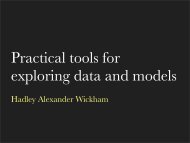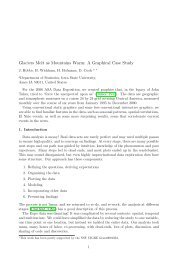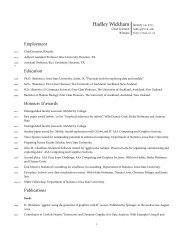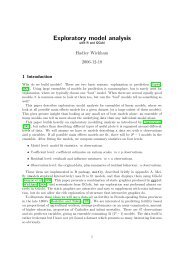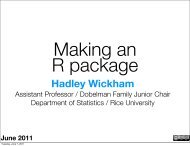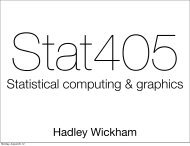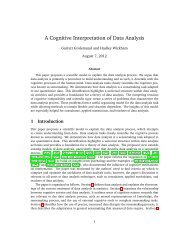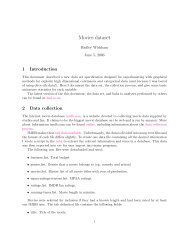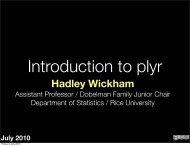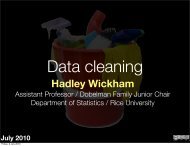Statistical inference for exploratory data analysis ... - Hadley Wickham
Statistical inference for exploratory data analysis ... - Hadley Wickham
Statistical inference for exploratory data analysis ... - Hadley Wickham
Create successful ePaper yourself
Turn your PDF publications into a flip-book with our unique Google optimized e-Paper software.
<strong>Statistical</strong> <strong>inference</strong> <strong>for</strong> graphics 4381<br />
might suggest that the pattern is strong (tips example, figure 4), but when<br />
it takes longer it might suggest that the signal is weak (HSBC 2005 <strong>data</strong>,<br />
figure 5), or the viewer is not as confident in their choice. It may be useful<br />
to ask the viewer to rate their confidence in their answer. Limiting the<br />
time it takes to answer may produce less reliable results.<br />
(iii) Readers will respond differently to the same plots, depending on training<br />
and even state of mind (Whitson & Galinsky 2008). There are, however,<br />
common traits that we should be aware of and expect to see from all<br />
viewers; <strong>for</strong> example, our visual perception responds strongly to gaps,<br />
colour inconsistencies and effects in the edges of plot regions, but may<br />
not pick up smaller deviations in large patterns. Subjectivity of results in<br />
visual test procedures is unavoidable. The Rorschach protocol may help<br />
to determine the baseline <strong>for</strong> each individual.<br />
(iv) Use of these protocols might have positive effects on improving statistical<br />
graphics used in the community. Because analysts are <strong>for</strong>ced to think about<br />
the null hypothesis associated with a plot, it may hone their abilities to<br />
choose appropriate graphics <strong>for</strong> their tasks. With additional work, the<br />
use of good principles in constructing plots might also be improved: preattentive<br />
plot elements <strong>for</strong> the <strong>data</strong>, attentive plot elements <strong>for</strong> grids and<br />
axes to allow look up only when needed.<br />
(v) In Tukey’s approach to EDA, <strong>analysis</strong> was sometimes done in an iterative<br />
manner: strong patterns are removed and the residuals are re-tested to<br />
reveal fine scale patterns. To use this approach, care might be needed to<br />
avoid bias of the secondary tests by exposure to the primary-stage plots.<br />
(vi) One way to reach a substitute <strong>for</strong> a jury could be the use of a Web<br />
service such as Amazon’s (2008) Mechanical Turk. Sets of plots based<br />
on the lineup protocol will be evaluated by the so-called human ‘turkers’,<br />
thus enabling us to gauge family-wise Type I error rates <strong>for</strong> each <strong>data</strong><br />
situation. It also allows us to easily capture time until completion of the<br />
task, an explanation <strong>for</strong> the individual’s pick in a lineup, together with a<br />
(subjective) confidence rating. While ‘turkers’ do not have the make-up<br />
of a representative population sample, we can collect some demographic<br />
in<strong>for</strong>mation with the results and try to correct <strong>for</strong> that. The Mechanical<br />
Turk has also been used to collect <strong>data</strong> <strong>for</strong> the Fleshmap project by<br />
Viègas & Wattenberg (2008).<br />
These points suggest directions <strong>for</strong> future research. We hope the paper provides<br />
something of a road-map to the incorporation of graphical discoveries as an<br />
integral part of statistical <strong>data</strong> <strong>analysis</strong>, consequently enhancing our ability, as<br />
statisticians, to handle increasingly difficult <strong>data</strong> problems. As an example, the<br />
plots in this paper were made using the R package, ggplot2 (<strong>Wickham</strong> 2008),<br />
using new functions which semi-automate the lineup plot <strong>for</strong>mat.<br />
This work has been partly supported by National Science Foundation grant DMS0706949.<br />
References<br />
Amazon. 2008 Mechanical Turk. See http://aws.amazon.com/mturk/.<br />
Atkinson, A. 1981 Two graphical displays <strong>for</strong> outlying and influential observations in regression.<br />
Biometrika 68, 13–20. (doi:10.1093/biomet/68.1.13)<br />
Phil. Trans. R. Soc. A (2009)<br />
Downloaded from<br />
rsta.royalsocietypublishing.org on January 7, 2010



